Nature in the City : Railtrails, Prairie Birds, and Bison
It was another hot sunny morning as we made our way back through the subdivision to meet up with the Harte Trail again the next section of the Trans Canada Trail in Winnipeg Manitoba.
As we were heading to the trail a friendly young lady pushing her baby in a stroller asked us where we were hiking and why. When she learned we were interested in birding she mentioned that there were Yellow-headed Blackbirds living in the newly constructed drainage pond in the middle of her subdivision. We walked with her to the cattail-lined pond, and sure enough, we heard the somewhat prehistoric sounding calls of these incredible birds! We were delighted to see how effective the simple urban restoration efforts had been in supporting birds, and that this random encounter had given us a new species!
As we continued down the Harte Trail we soon discovered it had a very sweet personality. There were small painted bird feeders hanging in the branches of the trees on either side of the trail. Each road crossing was marked with a hand-painted wooden sign showing a different bird along with the street name. These artistic markers reminded us of the handcrafted signs along Newfoundland's East Coast Trail. Periodically we passed benches, each of which had a unique quote on a plaque, and some of which were accompanied by flower boxes and drinking bowls for dogs.
The shady and tree-lined trail was full of people out cycling, jogging, and walking. Progress was slow because many of these friendly folks stopped to chat. Many people asked about our Radical Design carts. A grandfather and his young granddaughter told us they are planning to cycle across Canada together in a few years. It was clear that Winnipeg has a very active and engaged outdoor community, and everyone had a smile and a few kind words for us.
Historical plaques along the way informed us that we were passing the former site of the Pacific Junction Train Station and the Searle grain elevator. We were following the route of the Grand Trunk Pacific Railway which continued west to Prince Rupert, BC. The Grand Trunk Railway fell into financial difficulties when its owner sunk with the Titanic in 1912, and it was taken over by the Canadian National Railway after WWI. The Prairie Dog Central Railway began operation in 1970, and ran until 1974.
When we reached the end of the Harte Trail we emerged onto the Thundering Bison Trail, which was a paved bicycle route running parallel to a busy road. We followed this past a horse farm, and then into a commercial area where we stopped for an iced coffee at Tim Hortons, which gave us a much appreciated break from the heat.
The path soon diverted onto a well-used mountain biking trail, and then took us over a small grassy hill into the FortWhyte Alive Tallgrass Prairie Reserve. Restoration and wildlife conservation efforts have been underway at FortWhyte Alive since the 1950's, and it now features an interpretive centre and a winding trail system which offers abundant birding opportunities in grassland, forest, marsh, and aquatic habitats. In spring and summer it is possible to spot American White Pelicans, Great Egrets, Black-crowned Night Herons, and a wide variety of songbirds in this urban nature reserve.
As we made our way through the grassland section the cool breeze was filled with the sweet smell of blooming wildflowers. Feathery grasses swayed in the wind, and bees and monarch butterflies visited the delicate yellow, purple, and white wildflowers. The songs of Clay-coloured, Grasshopper, Vesper, and Song Sparrows, Western Meadowlarks, Bobolinks, and American Goldfinches rang out through the grasslands.
A short distance later the winding crushed stone dust trail brought us to the edge of a much larger pond that was filled with ducks and Canada Geese paddling about in the open water. In the background cyclists skillfully navigated the winding trails of the Bison Butte Mountain Bike Course, zipping down the maze of dirt tracks on the side a steep grassy hill.
significance habitat. Today only about 0.5% of the original 6,000 sq km of tallgrass prairies remains.
At one time, 30-60 million Plains Buffalo roamed the grasslands and prairies of North America between what are now Mexico and Canada. Sadly, by the 1800's bison hunting and indiscriminate slaughter by European settlers had brought these animals, which played an essential role in shaping grassland ecosystems, to the brink of extinction. Grasslands are now one of Canada's most endangered ecosystems, making restoration and protection of these amazing animals, and all the birds and other wildlife that rely on the habitat they share, extremely challenging.
After the short break we headed off down a set of narrow, floating, wooden boardwalks leading through a series of small ponds and marshes. The hot afternoon was pretty quiet, but we enjoyed watching Painted Turtles of all sizes basking on small logs and floating in the duckweed. American Goldfinches and Yellow Warblers moved busily around in the willows at the edges of the pond. A Grey Catbird surreptitiously fed her fledglings at the pond's edge, and Cedar Waxwings foraged openly in the tree tops above. Mallards and Canada Geese paddled lazily around in the water, and the raucous calls of Red-winged Blackbirds filled the air. It was easy to imagine that this would be a spectacular spot for birding during spring and fall migration.
Remember to follow our entire adventure here : www.comewalkwithus.online



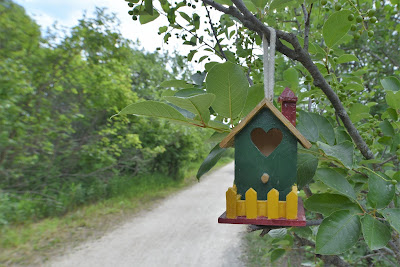



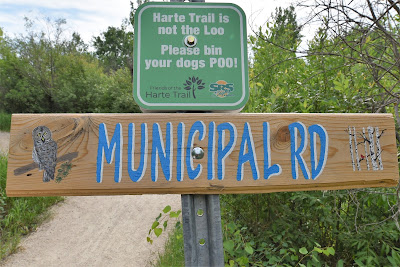









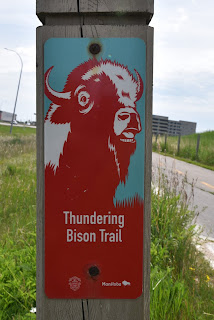






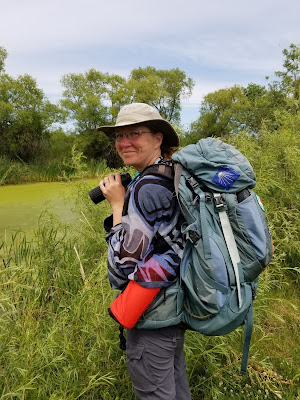





















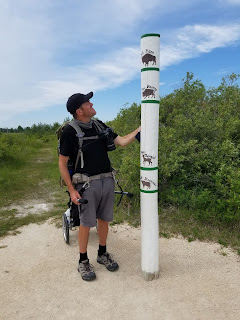


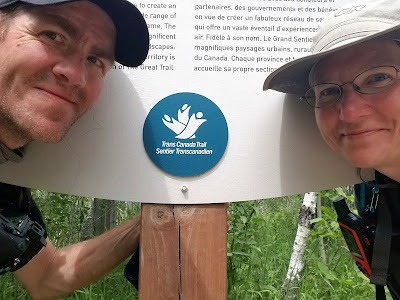













Comments
Post a Comment